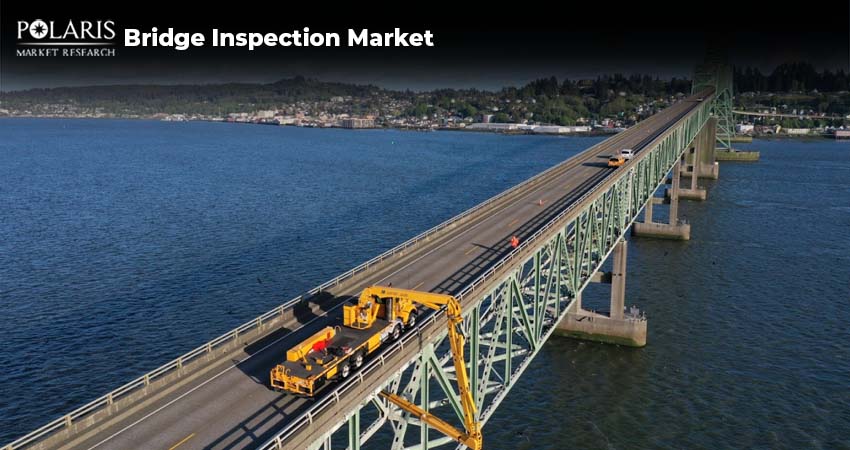Bridge Inspection System Market: Is Technology Shaping Bridge Safety?

Bridges play a vital role in our transportation infrastructure, connecting communities and facilitating the movement of people and goods. With thousands of bridges aging and facing structural stress due to heavy traffic, extreme weather, and material fatigue, timely inspection has never been more critical. Traditional manual inspections, while essential, are often time-consuming, labor-intensive, and prone to human error. Today’s bridge inspection systems leverage advanced technologies such as drone-based bridge inspection, LiDAR, AI-powered imaging, and digital twins to provide more accurate and efficient assessments.
As the demand for smarter infrastructure grows, bridge inspection systems are evolving into vital tools for governments and civil engineers committed to safeguarding public safety and optimizing infrastructure investments. Let's delve into this blog to learn how bridge inspection systems work, emerging trends, and their major applications.
What Are Bridge Inspection Systems?
Bridge inspection systems are specialized tools and technologies designed to aid in the assessment, monitoring, and maintenance of bridges. They are developed to assess the condition and structural integrity of bridges, ensuring their safety and longevity. These systems involve a range of methods, from visual inspections to sophisticated technologies, to identify potential problems before they lead to failure. The key aspects of bridge inspection systems include visual inspections, non-destructive testing (NDT) & inspection, mobile bridge inspection units (MBIUs), drones, and other technologies. The primary goal of bridge inspection systems is to ensure the safety and reliability of bridges by detecting and addressing potential problems before they lead to structural failures.
The bridge inspection system market was worth USD 980.0 million in 2023. At a CAGR of 5.4% over the forecast period, the market is projected to increase from USD 1,031.9 million in 2024 to a value of USD 1,569.2 million by 2032.
Why Is Inspecting a Bridge Crucial?
Inspecting bridges is crucial for ensuring public safety, preventing costly repairs, and extending the lifespan of these vital transportation infrastructure elements. Regular inspections help identify potential problems early, allowing for timely maintenance and repairs and preventing accidents and major disruptions to traffic flow and commerce. The bridge inspection system market has emerged as a solution to streamline and enhance bridge inspections, enabling more efficient and accurate assessments.
Key Bridge Inspection Market Trends
-
Non-contact Inspection Technologies: Terrestrial Laser Scanners or TLS, along with UAV photogrammetry, create detailed 3D models of bridges, enabling accurate measurements and identification of structural defects. UAVs equipped with advanced imaging and sensing technologies, such as high-resolution cameras and LiDAR, allow for efficient and detailed bridge inspection. Digital Image Correlation (DIC), a vision-based sensing technology, tracks surface deformation and helps identify crack initiation and growth in fatigue-prone areas.
-
Data-Driven Methods and AI: Data-driven methods and artificial intelligence are transforming bridge inspection systems by enabling automated, efficient, and precise assessments through technologies like machine vision and deep learning. AI models, particularly machine learning (ML), can analyze vast amounts of data collected from IoT sensors, smart devices, and even vehicle-bridge interaction data to detect subtle changes in structural health and predict potential failures.
- Non-Destructive Testing (NDT): Non-destructive testing (NDT) is being increasingly used in bridge inspection systems. NDT focuses on identifying internal defects and providing a more comprehensive evaluation of bridge health without causing damage. NDT methods are gaining popularity in bridge inspection due to their ability to detect hidden issues that visual inspections might miss.
- Bridge Information Modeling (BIM): BIM is increasingly used in bridge inspection systems to enhance efficiency and accuracy. It provides a comprehensive digital representation of a bridge, including its physical and functional characteristics, and serves as a central repository of information throughout its lifecycle. By integrating inspection data with the BIM model, inspectors can visualize and analyze bridge conditions more effectively, leading to better decision-making and improved maintenance planning.
Major Applications of Bridge Inspection Systems
Early Detection of Defects
Bridge inspection systems, utilizing technologies like computer vision and deep learning, play a crucial role in the early detection of defects. The early detection helps prevent catastrophic failures and ensures the safety of bridges. These systems automate and enhance traditional inspection methods, allowing for more precise and efficient identification of damage like cracks, spalling, corrosion, and other structural issues. They help pinpoint small defects and potential problems, preventing them from becoming major structural problems. Some systems provide real-time data analysis and monitoring, allowing for immediate identification of issues and alerts.
Enhanced Infrastructure Management
Bridge inspection systems, especially those incorporating digital technologies, significantly enhance infrastructure management by providing a more accurate, efficient, and proactive approach to maintaining bridge safety and longevity. These systems help identify potential problems early, optimize maintenance schedules, and improve decision-making, ultimately leading to safer and more cost-effective infrastructure management. The data collected by these systems allows engineers to make informed decisions regarding maintenance, repairs, and upgrades.
Improvement in Safety
Bridge inspection systems, encompassing various technologies and methods, are crucial for enhancing bridge safety by enabling early detection of defects and potential problems. These systems help identify issues before they escalate into major structural failures, preventing catastrophic incidents and ensuring the safety of users. Regular inspections and monitoring enable proactive predictive maintenance planning, allowing engineers to address minor issues before they escalate into costly and time-consuming repairs.
To Sum It Up
In conclusion, the bridge inspection system market is growing significantly as governments and infrastructure operators recognize the importance of maintaining safety and integrity. As infrastructure continues to age, bridge inspection systems play a crucial role in ensuring the safety and longevity of our bridge networks, ultimately facilitating the smooth and secure movement of people and goods.
With the world moving toward smarter cities and connected infrastructure, bridge inspection systems will play an increasingly pivotal role in supporting sustainable development and modern urban planning. Embracing this technological shift is key to building safer, smarter bridges for future generations.

